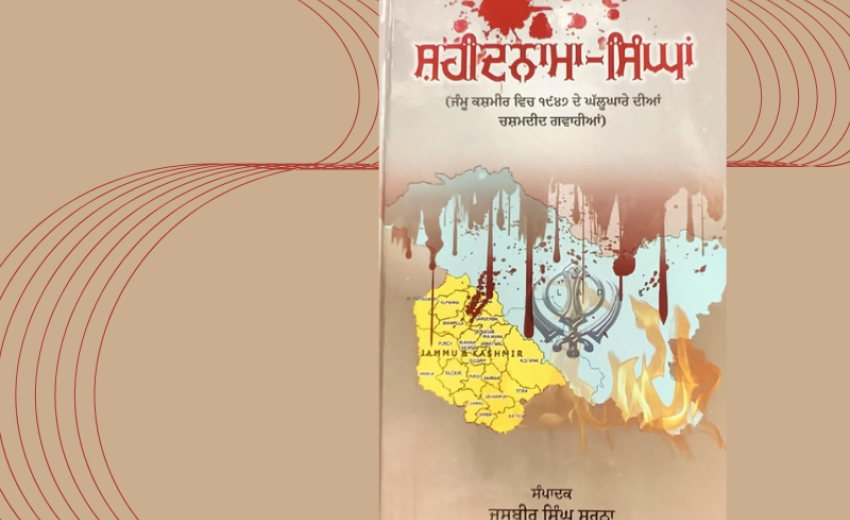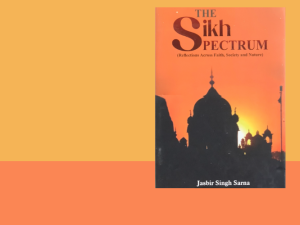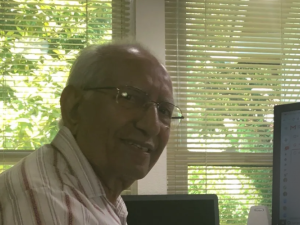Book Review
Bearing Witness to the Unseen: A Review of Shaheed Nama Singhan (Eyewitness Accounts of 1947 Sikh Martyrs in Jammu and Kashmir)
Author: Dr. Jasbir Singh Sarna
Publisher: Sant and Singh Publisher, J&K ( Contact :09906566604)
Available: Singh Brothers Amritsar, Price: ₹750 HB
Review by Bhai Dr Harbans Lal (USA), [email protected]
In Shaheed Nama Singhan, Dr. Jasbir Singh Sarna has performed a profound act of Panthic seva, preserving an essential yet underexplored chapter of Sikh history with care, scholarly
rigor, and deep moral responsibility. This meticulously documented volume, encompassing 448 pages of eyewitness testimonies, archival references, and hard-won fieldwork, illuminates the devastating and heroic experiences of Sikhs in Jammu and Kashmir during the cataclysm of 1947, a tragedy too often submerged under the larger narratives of Partition.
As a scholar of Sikh studies, I have long felt that the pain and resilience of the Sikh community during the Partition in the region of Jammu and Kashmir remain insufficiently acknowledged in contemporary historiography. Dr. Sarna has courageously stepped into this gap, visiting villages, speaking to survivors, retrieving the voices of women, children, and elders who bore witness to brutality, displacement, and martyrdom, and weaving them into a historical and spiritual tapestry.Dr. Sarna carefully contextualizes the political climate of Jammu and Kashmir during 1947, tracing its history from the Lahore Darbar under Maharaja Ranjit Singh to the Dogra rule of Maharaja Hari Singh. His crisp exposition of the political hesitations, the tribal invasions supported by the Pakistani state, and the urgency that led to the accession to India, provides readers—especially the younger generation—with a clear understanding of why the massacres and forced migrations occurred, and how these geopolitical forces impacted Sikh lives and faith in the region.
The heart of Shaheed Nama Singhan lies in its collection of eyewitness accounts—unfiltered, raw, and profoundly human. Dr. Sarna preserves the original language and sentiment of these testimonies, providing not only historical data but also the emotional truth of the tragedies. The voices echo with the screams of those who witnessed the abductions in Muzaffarabad, the brutalities in Mirpur and Poonch, and the torching of Gurdwaras in Baramulla. These accounts, meticulously sourced and cross-referenced, remind us of thespiritual valor of the Singhs and the fortitude of Sikh women in resisting violation and displacement. This method of preserving the sach di gawaahi (testimony of truth) elevates this work beyond mere historical documentation; it becomes a moral archive, aligning with the Sikh tradition of remembrance as resistance.
Dr. Sarna’s inclusion of four well-curated appendices—detailing village-wise lists of martyrs, translations of non-Sikh accounts from Urdu and English, and original correspondences such asletters from women held in captivity—expands the book’s utility for future researchers. The systematic cataloguing of martyr names, with Gurmukhi script indexing, ensures that ShaheedNama Singhan becomes a reference text for serious scholars of Sikh history, Partition studies, and Jammu and Kashmir’s socio-religious transformations. This quality, often missing innarrative-driven histories, ensures that Dr. Sarna’s work will guide future projects seeking to uncover the silences of Partition history, providing reliable data for verifying the sacrifices made by the Sikh community during this era.The Sikh tradition emphasizes yaadgar—sacred remembrance of sacrifices—and Dr. Sarna’s work extends this spiritual practice into scholarly form. In doing so, he follows the path of Bhai Balwant Singh Chatrik, Ishar Singh Baksh, and others who have previously captured echoes of the 1947 tragedy in poetic and prose forms, but expands it into a comprehensive historical document. At a time when state-sponsored and politically influenced histories ofPartition often dilute or overlook the Sikh experience in Jammu and Kashmir, Shaheed Nama Singhan serves as a corrective, ensuring that these martyrs are neither anonymized nor forgotten, but are recognized as integral to the narrative of Sikh resilience and the Panth’s struggle for dignity.
Beyond its academic contributions, Shaheed Nama Singhan is an act of moral courage, demanding that we confront the uncomfortable truths of history. Dr. Dharam Singh notes that this effort stands as a “lamp” for researchers who, like Faiz Ahmed Faiz, seek to find stories of travelers who perished at night. Dr. Sarna finds these stories and ensures they are spoken aloud, shared, and integrated into the living memory of the Sikh Panth. Shaheed Nama Singhan is more than a book; it is a memorial in words, a call for remembrance, and a scholarly map for future generations. Dr. Jasbir Singh Sarna’s work ensures that the martyrs of 1947 in Jammu and Kashmir are given their rightful place in Sikh consciousness, and their sacrifices are honored through the preservation of their truth. As we stand in an era where historical amnesia often erases the sacrifices of those who came before us, this work compels us to remember, learn, and carry forward the legacy of those who stood with unyielding courage against unimaginable violence. It is essential reading for scholars, Sikh youth, and anyone committed to preserving the integrity of historical truth within the Sikh tradition.
I wholeheartedly commend Dr. Sarna for his tireless dedication, scholarly precision, and spiritual integrity in producing Shaheed Nama Singhan. May this work inspire many to continue preserving and telling our history in our voices.






